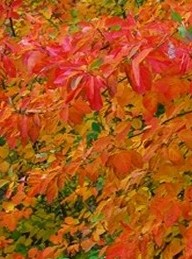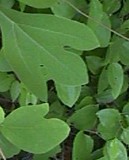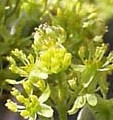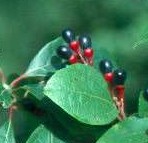 A deciduous shrub or tree, sassafras is native to eastern North America from Canada to Florida westward to Kansas and Texas where it is found in woods and thickets. It is probably best known for root beer made from the bark of its root but both bark and leaves are very aromatic and have been used in the past by Native Americans and British colonists for their medicinal qualities. Although trees can reach up to eighty feet sassafras can become shrubby if suckers are not removed. The leaves are bright green above, blue green below, and turn yellow, orange, red, or purple in the fall. They measure up to six inches long and four inches wide and may be oval or have two or three lobes. Clusters, of yellowish-green inconspicuous male and female flowers are produced on separate trees in spring. In autumn female flowers are followed by deep blue egg-shaped berries a half inch long that reveal attractive red pedicels when they fall off or are eaten by birds. The trees are broadly columnar with zigzag flexible branching. The red-brown bark is deeply furrowed and ridged. Difficult to propagate and establish, sassafras is hard to find in nurseries but makes a fine shade tree with outstanding autumn coloration.
A deciduous shrub or tree, sassafras is native to eastern North America from Canada to Florida westward to Kansas and Texas where it is found in woods and thickets. It is probably best known for root beer made from the bark of its root but both bark and leaves are very aromatic and have been used in the past by Native Americans and British colonists for their medicinal qualities. Although trees can reach up to eighty feet sassafras can become shrubby if suckers are not removed. The leaves are bright green above, blue green below, and turn yellow, orange, red, or purple in the fall. They measure up to six inches long and four inches wide and may be oval or have two or three lobes. Clusters, of yellowish-green inconspicuous male and female flowers are produced on separate trees in spring. In autumn female flowers are followed by deep blue egg-shaped berries a half inch long that reveal attractive red pedicels when they fall off or are eaten by birds. The trees are broadly columnar with zigzag flexible branching. The red-brown bark is deeply furrowed and ridged. Difficult to propagate and establish, sassafras is hard to find in nurseries but makes a fine shade tree with outstanding autumn coloration.
 Type: Deciduous tree or shrub
Type: Deciduous tree or shrub
Outstanding Features: Autumn coloration; bark
Form: Broadly columnar with horizontal branching
Growth Rate: Medium
 Bloom: Inconspicous yellow-green male and female flowers on separate trees in spring
Bloom: Inconspicous yellow-green male and female flowers on separate trees in spring
Size: 30-60’H x 25-40’ W
Light: Full sun to part shade
Soil: Average, moist, well-drained, acidic
 Hardiness: Zones 4-9
Hardiness: Zones 4-9
Care: Remove suckers if tree desired
Pests and Diseases: None of significance
Propagation: Difficult; root cuttings, seed.
